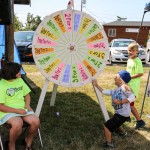Dillon Carpenter will be at the Hibulb Cultural Center September 13, 2014, at 1:30 p.m. for the Childrens Reading Time event.
Tag: Tulalip
CABIN GAMES RELEASES COVER ART FOR REDSKIN MIXTAPE “BIG RED”
Seattle, WA (9/3/2014) – Cabin Games emcee Redskin is gearing up to release a new mixtape titled Big Red, in which he spits hard-hitting rhymes over 14 classic Notorious B.I.G. instrumentals. This tribute to Biggie has been in the making for quite some time, and Redskin did not take the challenge of paying homage lightly, attacking each beat with the same calculated force and delivery as the last. With select features from Pez Paradise and Mya Rose, and mixing by Cabin Games producer Kjell Nelson, Big Red builds on the rapidly growing catalogue of dope music coming out of the Cabin.
The cover art for the mixtape features both the legendary Biggie Smalls and Redskin himself, and was designed by Native American artist Steven Judd. The project will be released on September 11th, 2014.
Cabin Games is a new music label co-founded in Seattle by Rich Jensen, former Co-President of Sub Pop Records, and Redskin, a Tulalip Tribal member. Current artists include Silas Blak, Hightek Lowlives, Pigeonhed, Richie Dagger’s Crime, Redskin, Yardbirds and Steve Fisk.
For bookings and more information about Cabin Games:
Contact:
Info@CabinGames.net
Storm drains with a message
By Brandi N. Montreuil, Tulalip News
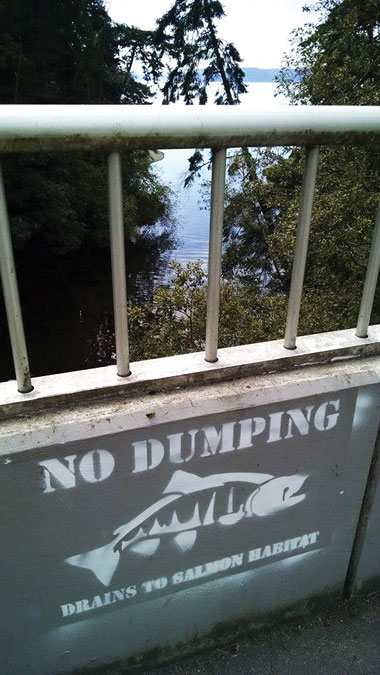
TULALIP – Through the summer break, 175 storm drains on the Tulalip Indian Reservation received a mini makeover due to a collaborative effort between Tulalip Tribes Natural Resources department and the Goodwill Aerospace Program.
Receiving help from 20 students from the Marysville/Everett area who participated in the Goodwill Aerospace program, the drains, located near the Tulalip Resort Casino, Totem Beach Road and Totem Beach Loop Road, now display a stenciled salmon graphic and custom message reading, “No Dumping; Drains to Salmon Habitat.” Tulalip Natural Resources hopes the message will remind the public of the risks salmon habitat face.
“Many people have the misperception that a drain in a street or parking lot is sent to a wastewater treatment plant, but it is not,” explains Valerie Streeter, Tulalip Natural and Cultural Resources stormwater planner. “ After a rain storm, stormwater runoff enters the drain and is usually piped directly to a ditch, stream or bay with very little treatment. This water picks up heavy metals, copper from brake pads, Zinc from tires, and oils from engines, and delivers these pollutants to our waterways. Salmon are especially sensitive to copper, which alters their response to predators and damages their olfactory organs, how they smell. Zinc and oils also damage aquatic plants and animals.”
Students involved in the program were required to participate in service learning projects, which involves learning about the science and background of a project and then volunteer their time toward that project.
“Protecting our watersheds and salmon habitat are very important and we want the community to understand that dumping anything down storm drains can impair fish and other aquatic creatures because storm drains drain directly to streams, lakes, and even the bay,” said Kelly Finley, Tulalip Tribes Natural Resources Outreach and Education Coordinator.
Streeter explains that when people wash their cars or driveway and either dump or allow the dirty wash water into the storm drains, this contributes to water pollution. “It is better to wash your car on the lawn or use a car wash, which are connected to wastewater treatment plants. Pet waste is another common pollutant in our water, which can pass diseases on to other animals or even us humans.”
“The worst is an old practice of dumping used oil from an oil change into the storm drains,” said Streeter, who recommends discarding used oil at appropriate places, such as the automotive center at the Walmart Supercenter located in Quil Ceda Village, who will discard the oil free of charge.
For more information on how you can help in salmon recovery, please visit Washington State Recreation and Conservation Office’s website at www.rco.wa.gov/salmon_recovery/what_you_can_do.shtml.
Brandi N. Montreuil: 360-913-5402; bmontreuil@tulalipnews.com
Relocation turns pests into assets: Beavers help salmon and ease the impacts of climate change
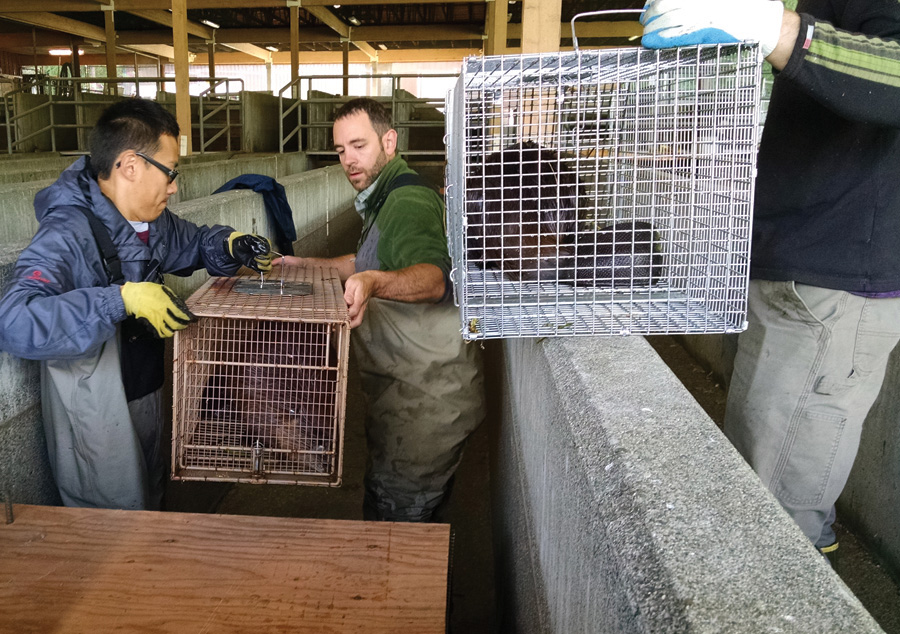
Photo/Niki Cleary
By Niki Cleary, Tulalip News
Beaver are known for their industrious landscaping. They regularly use their skills to rearrange the world around them, much like humans, to build safe places to live and grow the plants they feed upon. Unfortunately, for businesses and homeowners, the beaver’s best-known talent is also one of its least charming attributes.
The solution? Move nuisance beaver from urban areas to Forest Service land in the mountains where their construction skills will both build salmon habitat, and mitigate the effects of climate change. A win-win that Tulalip Wildlife Biologist Jason Schilling is excited to share.
“Beavers are marvels of engineering, we’re hoping to tap into their ability to store water,” he explained. “This was a big vision of Terry Williams [Tulalip Natural Resources], he saw it as a way to restore degraded landscape.”
“Benjamin Dittbrenner [of the University of Washingon], is studying how beaver change water quality,” Schilling continued. “ Particularly he’s looking at stream flow before and after beaver relocation and water temperature, those are two very important things for salmon.”
Dittbrenner is a former Snohomish County employee. While at the County he worked with landowners to ensure that property was protected from beaver activity.
“Beavers have a lot of really great ecological benefits,” he explained. “They take water and slow it down so that it can infiltrate into subsurface soils, increase groundwater and recharge aquifers. This creates backwater habitat for specialist species, and there have been studies to show that beavers and Coho are closely linked, Coho use beaver habitat as juveniles. We suspect that part of the reason Coho numbers are dropping is lack of beaver habitat.”
Dittbrenner continued, “The climate shifts that are predicted in the mountains mean that we’re going to have a lot less snow. That snow directly provides water to streams in spring and early summer. If there’s less water that means there is warmer water, and warmer water means less dissolved oxygen and less successful spawning. We’ve been looking at solutions to cope with less and warmer water.”
The project will work, said Dittbrenner.
“We’re modeling the project after other projects, east of the Cascades, where it’s legal to relocate beavers. Ranchers who once were against beavers are seeing that when the beavers come in, the groundwater levels increase and their pastures stay greener much longer. We’re hoping to see the same great benefits that they’re seeing.”
In a nutshell, the beaver’s dam building creates ponds which helps increase the water table. Beavers slow down water during fast flow times and increase water during the dry season. All of which adds up to more, and better quality water, as well as rearing habitat for salmon. Lastly, as climate change causes the snowpack to decrease, beaver ponds are an effective and natural way to store water for the dry season.
Since it’s such a great solution, why isn’t everyone doing it? Because in Western Washington it’s illegal to transport beaver alive from where they are trapped. It’s still perfectly legal to kill them. Tribes, however, are not subject to state law.
“It really has to do with our management of wildlife, as part of our broader treaty rights in off-reservation resource management,” explained Tulalip Attorney Tim Brewer. “We have the right to manage these resources and we’re working with the feds on federal land and therefore state law is pre-empted.”
Tulalip biologists have 24 beaver friendly sites picked out, but only eight of the sites will be populated initially. The unused sites will be used to as a comparison to demonstrate how effective the project has been.
“We may use them as release sites next year,” said Schilling, “but that will give us some good baseline data for beavers we released.”
For more information about the project contact Jason Schilling via email jschilling@tulaliptribes-nsn.gov.
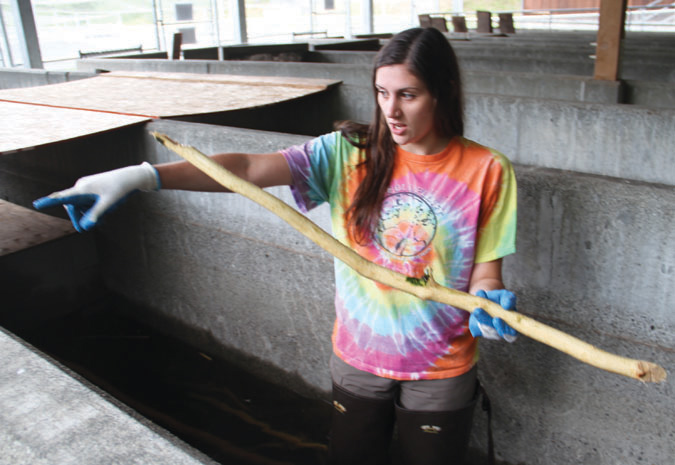
Beavers await relocation at the Tulalip Hatchery
Assistant Wildlife Biologist Molly Alves helps take care of beaver while they await relocation. She feeds them, dropping bunches of vine maple and vegetation, into the chum raceways where they are living. The beaver are also offered commercial rat food, but don’t seem to care for it. They sleep in man-made lodges built out of cinder blocks.
“We have to rebuild their lodges every night,” she said. “We weren’t anticipating catching six, and they don’t fit very well in a single lodge. The lodges are built out of plywood and cinder blocks, we have to line the plywood with steel mesh or they will chew through it.”
Alves explained that beaver are highly social and prefer to sleep together. That is one of the reasons they’ll be relocated as a group. Other strategies to ensure the animals don’t leave include scent marking the locations.
“We take these,” she held up the vine maple from the previous day, it’s bark stripped and the wood notched with teeth marks, “we call them chew sticks, and we’ll put them at the release site. They’re more likely to stay there if their scent is already there.”
The family is made up of two adults, three sub-adults and one kit.
“We’ve been setting up camera traps as well, so we know there are two more at the site where we caught this family,” said Alves.
“There’s another kit and a sub-adult. We’ll go back and catch those two and release them [as a pair],” she continued. “We know the sub-adults stick around for a couple of years to take care of the kits, so we know the kit will be fine. They’ll be released as their own family and they’ll probably go to a different spot because by the time we get them, these ones will be established.”
While the cameras are useful, Alves said the biologists knew there were more beaver because the animals can’t stand a leaky dam.
“There were three dams where we caught these guys. We notched the dams, that means we pulled out sticks and mud so there was a trickle of water,” she described, “it drives them crazy. When we went back some of the dams were rebuilt.”
Beaver are nocturnal herbivores, although they don’t hibernate, their planning and construction ensure that they survive winters just fine.
“They eat leaves in the summer and bark year round,” Alves said. “They stay in their lodges all winter and they create caches of food under their lodges. Other animals like muskrats and mice will stay in their lodges too.”
Hatchery visitors can learn about the beaver through series of interpretive signs that describe the relocation project and it’s benefits.
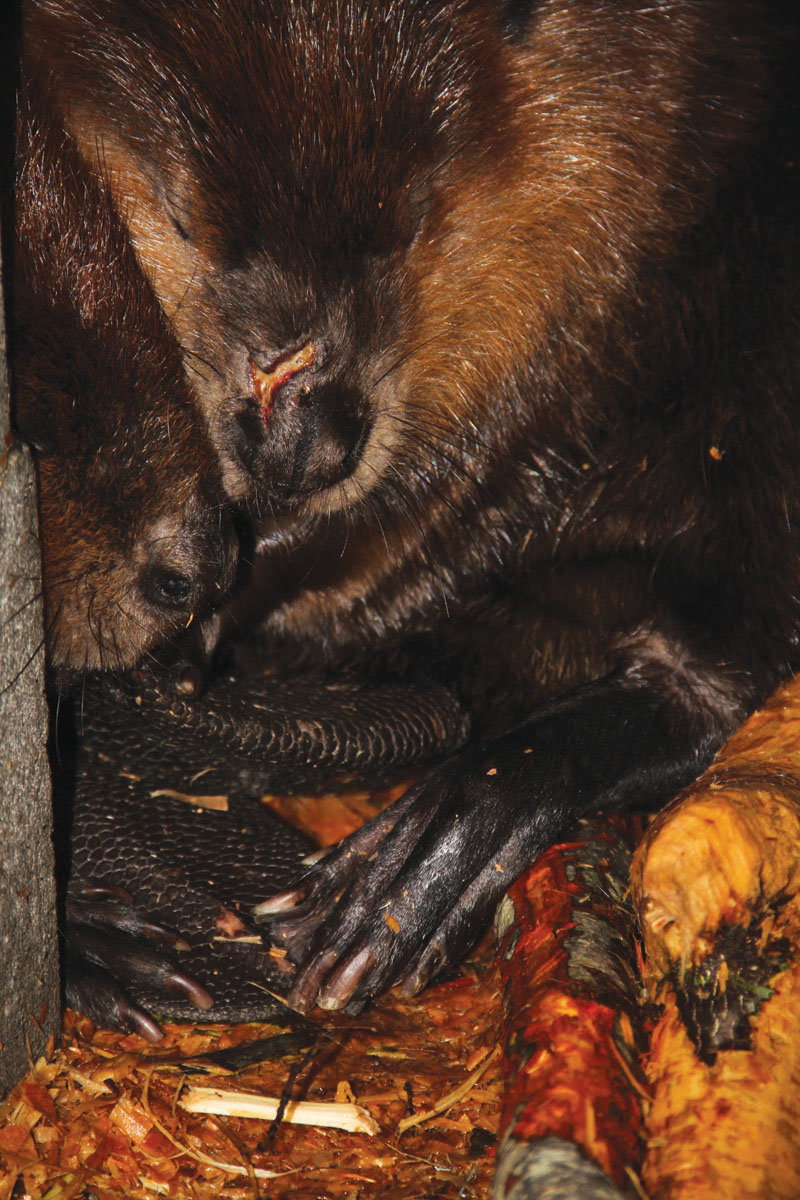
CCR tribute band to be Up Around the Bend playing at Tulalip
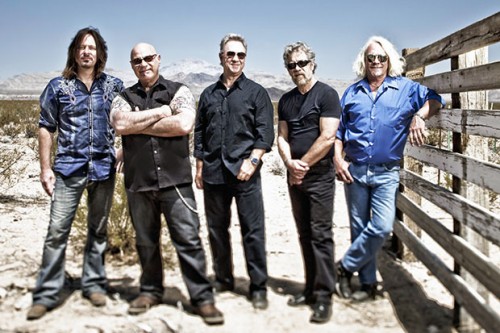
— image credit: Courtesy photo
By Brandon Adam, The Arlington Times
TULALIP — They toured alongside John and Tom Fogerty during the 1960s as the driving rhythm for Creedence Clearwater Revival, and they’ll be performing at the Tulalip Amphitheater Sunday, Sept. 7.
Tulalip man, 25, dies in crash
Woman killed in Tulalip crash ID’d
By Herald staff, The Everett Herald
TULALIP — A woman killed in a car accident on the Tulalip Indian Reservation earlier this week has been identified as Gina M. Fletcher, 47, of Chelsea, Oklahoma.
The one-car crash happened about 8:30 p.m. Tuesday on Marine Drive at Hermosa Beach Drive. Fletcher was believed to be the passenger. She died at the scene.
A 49-year-old man who was believed to be the driver was injured and taken to the hospital.
The Snohomish County Sheriff’s Office is investigating. No additional information has been released.
1 killed, 1 seriously hurt in crash near Tulalip reservation
By Komo staff, KomoNews.com
TULALIP, Wash. – Speed and alcohol are believed to be factors in a one-car crash that left a woman dead and a man seriously injured Tuesday night near the Tulalip reservation, officials said.
Deputies and medics were dispatched to the scene, Marine Drive near Hermosa Beach Drive, at about 8:30 p.m. after receiving a report of a serious crash, said Shari L. Ireton of the Snohomish County Sheriff’s Office.
Responders found a 47-year-old woman dead at the scene.
A 49-year-old man, believed to be the driver of the vehicle, was seriously injured. He was taken to Providence Hospital for treatment.
Speed and alcohol were both believed to be causing factors, but the incident remains under investigation, Ireton said.
Marine Drive was closed between Hermosa Beach Drive and 83rd Place NW for several hours for the accident investigation, but has since reopened.
The names of the crash victims were not immediately released.
iheart Go! hosts block party at Tulalip Boys & Girls Club
The group, comprised of volunteer youth in grades fourth through eighth in the Marysville area, and church staff, are spent the week of August 5-9 reaching out to the Marysville/Tulalip youth through fun block parties that feature, games, bouncy houses, face painting and crafts.
The Tulalip Boys & Girls Club is one of five locations that iheart Go! youth, known for their identical bright neon green t-shirts, reached out to.
“It’s wonderful what you [Tulalip] dofor the kids at the Boys & Girls Club and the Grove Church is excited to be a part of this learning partnership. I love outreach and I love working with kids,” said Patty Thometz, Children’s Pastor at the Grove Church in an earlier interview with Tulalip News. “We couldn’t ask for a better day, the weather was gorgeous and we are so happy to be here. I think the kids are enjoying themselves.”
Foes blast M’ville fireworks; a few speak out for them
By: Steve Powell, Marysville Globe
MARYSVILLE – Despite evidence to the contrary every July 4, more residents favor a ban on fireworks than support continuing them.
That is according to an unscientific survey taken the past week by The Marysville Globe. After the City Council discussed options, including a ban, July 28, the Globe asked readers for their opinions.
By a wide margin, respondents favored a ban, but the few in opposition were just as passionate.
No ban needed
“I am very much against the fireworks ban,” said Ralph Woodall, who even had his front yard burned up by a safe and sane firework this year. “We enjoy them every year.”
Amy Burt added: “One of the events that the kids in our neighborhood look forward to every year is July 4th. It’s one day a year. I think it’s good for the community as it brings everyone together to share in the fun. We always clean up afterwards, too.”
Maribeth Woodall said it’s only once a year, and many organizations benefit from the sales of fireworks. “Let’s not ban all just because of a few,” she says. “It’s a special time, and we and many friends love the beauty and even the noise. I would hate to see it end.”
Pam Salas says: “The 4th of July is an American celebration of freedom, and one of the few times a year we get to feel like we have freedom. The 4th of July fireworks in Marysville bring families and neighbors together in celebration. My family, for example, had not celebrated a holiday together in 10 years. What the ability to have our own fireworks display did was bring my family from around the country together. They enjoyed it so much that we all want to make it a yearly event.”
Lance Van Winkle got upset with some council members not wanting to get public input on the issue. He said he sometimes gets irritated by it all.
“Then I realize it’s once a year. It’s a celebration of our country’s freedom, and it maybe means more than it seems on the surface,” he says in an email. “Your ban rant seems ridiculous” considering all of the fireworks sold in the area.
Van Winkle said the council should focus on more important things.
“Why not focus your limited resources on things like panhandlers, drug dealers, thieves, vagrants and the like that we citizens put up with every day, not just once a year. Let people ‘blow off’ a little steam,” he says.
Most favor ban
But a wide majority of the almost 30 respondents agreed with Shelly Baker.
“Every year on the Fourth of July it is literally like a war zone around here. And these are not the safe and sane ones – we know they were all at Boom City buying theirs. The mess left behind that nobody seems to think is important to clean up (and this is a nice neighborhood), the trauma to pets, and not being able to go to sleep until sometimes well after midnight is a problem for many.”
Baker said a ban would be hard to enforce. “At the very least it would likely curb some of it, but I am skeptical that it will ever go away,” she wrote in an email to The Globe.
Donna Trevino had similar sentiments.
“It’s like a war zone all around my house with people at almost every home, out in front of their house shooting off fireworks, with no knowledge of what they are doing. Some are shooting off sideways, barely missing people and children. If you have a fireworks display from one place in Marysville, where people could go and watch, that would be fine. But this FREE-FOR-ALL has got to STOP.”
Other respondents had many reasons for wanting a ban.
“I get asthma from the smoke. My dog has to take medicine. In my neighborhood the fireworks start on June 23 and go to about July 6,” Joanne Thorleifson says.
Royann Almond’s email says: “All fireworks should be banned for the safety of our city! Since the houses being burned down cannot be traced back to origin, outlawing all, could solve noise, air pollution, bodily harm, frightened animals and property!”
Morgan Magaoay says: “These are no longer just firecrackers, they are bombs. There is no regard to property and safety for people and the suffering of animals.”
Goes on too long
Other respondents focused on singular issues. Many say they can handle fireworks on the Fourth, but not weeks before and after.
Jeri Williams said fireworks are shot off illegally long before and after the 4th. “They shoot them off day and night,” Williams says, adding she also supports a ban to ease the enforcement load on the fire and police departments.
Wendy Clark said she doesn’t like fireworks going off June 15 to July 15, nor from Dec. 1 to Jan. 15.
“We are forced to sedate our dog on many of these evenings as she becomes so stressed and emotionally frantic that nothing short of knocking her out gives her any relief,” Clark’s email says.
She says this year’s Fourth far exceeded the prior three years’ noise, “booms” and acrid smell. The magnitude in amount, duration, scope and intensity was “injurious, unfriendly, inconsiderate and very unfortunate.”
She added, “Boom City was not responsible for ALL of this objectionable hullabaloo.”
“Our Independence Day and New Year’s Eve holiday celebrations should include more than terror and fear. Maybe we need to encourage more focus on the TRUE meanings behind these celebrations: our independence, the service of the men and women in the military, the dedication of our veterans, and the many freedoms and liberties we enjoy by living in the United States of America,” she says.
Others said the true meaning of the holiday is being lost.
Kathy Franzwa says, “Most of them are not celebrating our freedom–-they’re looking for an excuse to make obnoxious noise with callous disregard for our veterans and animals. There were many times this summer when the cannon-like explosions seemed to be in my back yard.”
Phyllis and Bob Mennenga say: “Some people just don’t know when to quit. Go to a fireworks show if you like them so much.”
Others said illegals fireworks on the Tulalip Reservation should be banned. However the city does not have jurisdiction over the reservation.
Ed Mohs says: “Ban the illegal, Tulalip Tribe Boom City-type fireworks. People in general are disrespectful and light fireworks at all hours of the night prior to and after the Fourth.”
Sheri and Pat Boober say: “I believe that Marysville should ban the Tulalip Indian fireworks stands being able to sell unsafe fireworks,” their email says. “There simply is no reason for people to have to have their houses shake for practically the whole month of July.”
John Muller says Marysville should ban fireworks like other cities have. “Just think about the peace of mind and the funds that could be saved to use on other projects within the city,” he says in an email. He added that the cost to the city each year is great, with fire department calls, injuries, aid cars and property damage. “The local indian tribe would not welcome any ban, but so be it,” Muller says. “They may do as they wish on tribal land, even open a fireworks park.”
Going to extremes
Some respondents go to the extreme to avoid problems.
David Bartos says: “We are forced to leave town over the 4th, not only because we do not like the excessive fireworks but one of our two dogs is absolutely terrified the entire time.”
Bartos said the lasting effects of the 4th are ridiculous.
“We heard some booms close to our house as recently as Aug. 1, four weeks after the 4th!” he says in his email. “Also in several areas within a five-block radius of our house, the mess in the street is terrible; it is still there, and no one cleans it up.”
Kay Anthony said: “I live in fear every year that my house will catch fire. I pray for rain every year, and most years it is very dry. I should not have to worry about my house burning down and tranquilize my pet for irresponsible people to get an expensive few minutes of thrill.”
Anthony added that since there are organized fireworks shows nearby, the city should not waste its money on a local display. “Funds can be better spent,” she says in an email.
Still others take it even further.
“It has made us think about moving,” Linda Hughes Freeth says. “It was so bad we spent the night in a hotel as it was too stressful to be at home.”
It wasn’t any better when she returned.
“On the 5th, we had to deal with all the debris on our lawn and cars. Even today, as I walk our dog in the neighborhood, I am still seeing remnants of the fireworks strewn on the sidewalks, lawns and street.”
She recommended that the city work with the Tulalip Tribes to have a show on the reservation.
Other respondents said they would be open to a show or having certain areas where people could shoot off personal fireworks.
Fred Schiefelbein wouldn’t mind a few designated spots where people could shoot them off with supervision. “I have seen my share of fireworks with three tours in Vietnam, and when people start shooting off a week before and a week after the fourth it gets a little old.”
Barbara Turpin says she stays at home on the Fourth to protect her house from fireworks. She says illegal fireworks should be banned. “I think the council is afraid to ruffle feathers; law should be law, illegal is illegal,” she says. For the future, “Maybe not doing fireworks at the (Strawberry) festival and making a combined celebration with fireworks on the 4th,” she says in an email.
Along with shooting them off too many days, the other big issue was people not cleaning up after themselves.
Don’t clean up
Dan Hennessey says: “Every year the block next to mine has a huge neighborhood ‘display’ that lasts for a few hours on the night of the 4th. The ‘carnage’ of fireworks litter is absolutely incredible the following morning. One elderly couple’s home had their yard so covered in this litter the green grass was barely showing through as they were out raking and bagging all the leftovers their considerate neighbors donated. I asked them if this was recurring, and the answer was six years ongoing.”
Bonnie Stevens says: “Each 4th of July our trees and home are covered with dangerous fireworks! This year we found a balloon-type object hanging in one of our trees (it comes with a candle attached).”
Herman Moya says: “We do not mind the safe and sane fireworks but not the quarter stick of dynamite ones. They just shake the house. The next morning I have to clean up the spent fireworks from my driveway, front yard and back yard. I have to use a roof rake to remove them from my roof. I am 75 and too old to get on my roof. I have to remove them from my rain gutters. The local kids started two weeks before the 4th: Bang, bang, bang for hours. I called the Marysville police, and they immediately came and talked with the kids. They stopped but were at it again in a few days.”
Carol Whitney said the Marysville Police Department would not enforce a ban if one was passed.
“What we need to do is hold the MPD accountable to enforce the ban/limited use law already on the books. If they took that law seriously then the fireworks would not be the huge problem that they are right now.”
Mary Anne Jones did a great job of summarizing the issue: “I am certainly all for showing our love of country, but here in Marysville, I think, some have gone beyond that. Even tonight, I hear the bang of fireworks. They have been blasted around in our area since June 6 every evening until about midnight, keeping my nerves on end and my dog shivering under the bed until wee hours of the morning. My husband often has to drive to a quiet park away from Marysville so that the little dog will go potty.
“I wonder, though, in this day and age, could we really enforce a ban? So many don’t care about what is legal. It is about what they want. I guess I would like to see the ban on private fireworks and police action to back it up properly. I think a community firework display on the 4th of July could be a good answer.”









